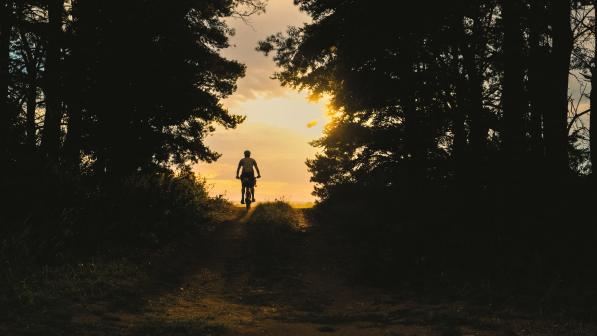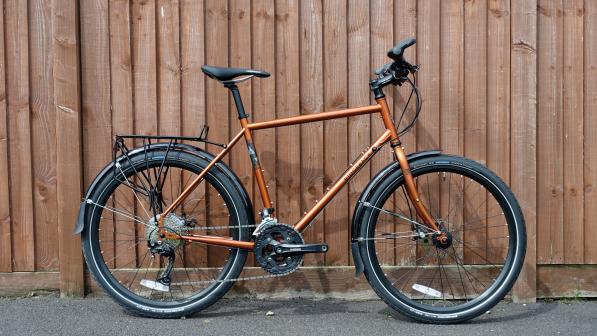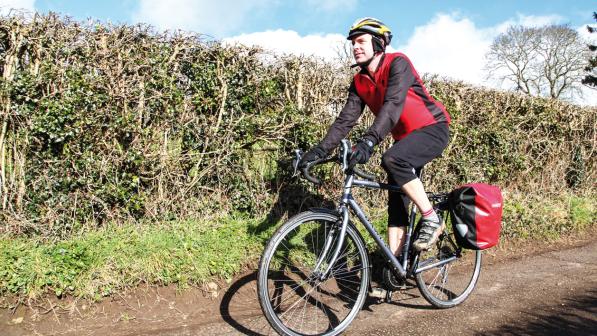Bike test: touring bikes for a grand
There aren’t many sub-£1,000 tourers around these days, with Trek’s 520 following the likes of the Dawes Galaxy into cycling history. The two test bikes do come in under a grand. But are they genuine tourers that will take you far and wide, despite their comparatively modest price tags?
Pleasingly, the answer is yes. The British-designed Ridgeback Tour and the Four Corners 1 from US outfit Marin offer two different takes on the touring bike – one traditional, the other more ‘gravel’.
Frame and fork
The Marin is old-school chrome-moly steel while the Ridgeback is aluminium (with a chrome-moly fork), but both are neatly made and have plenty of bosses. You can’t fit a full-size bottle in a standard cage on the Marin’s seat tube, although a side-entry cage would work, yet even without that you can carry three bottles on the main frame triangle.
Both bikes have quick-release dropouts for frame and fork, which is a little unusual in this era of thru-axles. It’s not a major issue at this price, however, and it didn’t seem to detract from the effectiveness of the bikes’ disc brakes.
Staying with the slightly retro theme: all the cabling is external. As a mechanic of modest skills, I’m always happy with that, even if internal routing looks neater.
Each bike also has separate rear rack and mudguard eyelets, plus room for wider tyres and mudguards. The Marin will take mudguards over its 45mm Vee tyres, or you could go for even wider rubber without.
Both test bikes are the medium option of five sizes, and they both have the slacker head angle you’d expect in a long-distance adventure bike. Seat angles are a little steeper than is traditional for a tourer. The Marin has a much longer wheelbase at 1,087mm, compared with the Ridgeback’s tighter 1,035mm.
Components
The Ridgeback Tour has a three-ring setup that shifts well but misses out on lower gears due to the fact that it’s a 50−39−30 road triple. Having three chainrings means smaller jumps between ratios, so you can usually find the correct gear for your cadence, but the 26in bottom gear is too high for a tourer.
On one occasion I found myself pushing the Ridgeback up a steep hill with heavy traffic passing closer than I’d have liked.
By contrast, the Four Corners’ lowest gear is just 21in, which is the sort of gear you need for loaded touring, especially when you hit the climbs. A Shimano Altus 44−32−22 chainset would have provided a 22in bailout gear for the Ridgeback, or a wall-climbing 18in gear if paired with a 34t cassette.
While Shimano’s 8−speed Claris gearing needs little introduction, the Marin has the less familiar 9-speed Microshift Sword. It works very well. Rather than a brake lever that doubles as a shifter, it has a dedicated brake lever and two paddles for changing gear.

On the right, the larger paddle shifts to a lower gear, the smaller paddle to a higher gear. On the left, the larger paddle shifts to the big ring. It takes a bit of getting used to but offers consistent and accurate shifting and a light action.
The sub-compact double chainset, a slightly unusual 46-29, is paired with an 11-38 cassette. This means there are inevitably bigger jumps between gears, with a six-tooth jump from the 32 to the 38 sprocket, but for me the much lower bottom gear is always a price worth paying.
Both have brakes typical for entry-level drop-bar bikes: cable-actuated discs. They’re a good choice: effective, even if they don’t have the light action of hydraulics, simple to fettle and still functional with a wonky rim. The Marin’s dual-piston TRP Spyre Cs take the honours for performance, edging out the Ridgeback’s single-piston Promax brakes.
There’s little to choose between the rest of the kit, with the alloy stems, bars and seatposts typical of pretty much any bike around this price; all are absolutely fine. While the specs suggest the bars have different flares, both actually measure 42cm at the hoods and 50cm across the drops.
The Ridgeback comes with mudguards and a rear rack, despite being cheaper than the Marin. The rack is tough and solid and the unbranded full-length mudguards have quick-release safety clips.
The ride
As well as numerous shorter rides, I rode both of these bikes for a number of loaded 60−mile rides on varied surfaces. Even over poor country roads comfort was good, and my longer rides took in extensive sections of rutted, uneven, rock-hard towpaths.

Both bikes delivered on their promise of long-distance comfort and the ability to carry loads without complaint.
If I were touring extensively on poor surfaces, I’d choose tyres that were wider and a bit more supple than the Ridgeback’s 32mm Vittoria Randonneurs. They feel as if they’d shrug off punctures well but were somewhat unyielding.
After 50 miles or so, I could feel this through the heels of my hands. I think the frameset itself is fine for comfort and that wider rubber or double-wrapped bar tape would be enough.
The Ridgeback’s flared bar and Madison Flux saddle are both sound choices and contribute to a bike that would make a very good entry-level tourer, long-distance commuter or day-to-day machine. Steep hills will be hard going if you’re carrying heavy loads, due to that high bottom gear.
The Marin has the widest tyres of any non-electric bike I’ve tested. The 45mm Vee Tire Quickstyx tyres measure a bump-smoothing 47.5mm on the rim. They were very good on canal towpaths and light gravel and super plush on tarmac.
Although the tyres are tubeless ready, the rims aren’t – something I don’t feel is an issue at this price. In spite of their extravagant width and shallow, knobbly tread, the tyres don’t feel as if they’re stealing your speed on the road. Grip off road is boosted by slightly larger tread blocks on the shoulders.

The wide tyres do take a bit of getting used to. Their higher mass and bigger footprint slow the steering slightly, which I particularly noticed at higher speeds. It’s really only a case of getting accustomed to the effect, however, as they’re lovely overall. Having said that, I’d probably switch them for something slightly narrower for tarmac-only touring.
The Marin’s extra-long wheelbase and high riding position deliver impeccable stability, with its compact, flared bar adding excellent control to the fatigue-free handling.
The Marin has a nice, upright touring-friendly position, with a higher stack than the Ridgeback added to even further by the stem. The shortness of that stem stops the Marin’s handling from getting too ponderous. I liked the saddle and the gel bar tape.
The Ridgeback isn’t quite as long or as tall at the front, though if you flipped its stem it would be closer. It nevertheless has a riding position that doesn’t put any strain on your back.
The Madison Flux saddle has a similar amount of squish – enough, but not too much – to the Marin saddle, and I think it’s equally comfortable. Both bikes are quite leisurely climbers.
In spite of the size of its tyres, the Marin’s bottom gear – around 20% lower than the Ridgeback’s – means you can stay seated and pedal for longer. Each cruises very well indeed on the flat.
You’re never going to be going as fast as you would on a road bike, but you’ll be going all day and will be able to take the rough with the smooth, too.
The steel Marin is a kilo heavier than the Ridgeback. This doesn’t matter for touring, when you and your kit could easily weigh 100 kilos, but might be noticed on unladen rides.
Verdict
I enjoyed riding both of these bikes and would happily own and recommend either for their comfort, practicality and affordability. Both have well-chosen components, with brakes, bars, bar tape and saddles I’d keep.
It’s great that the Ridgeback comes with a rack and mudguards, despite its £900 price, but I’d prefer more suppleness from the tyres and really, really want a lower bottom gear.
The Marin’s Microshift drivetrain excelled everywhere, especially on hills thanks to its 21in bottom gear. The steel frame and super-wide tyres proved comfortable companions on all surfaces, although I’d probably swap to 35-40mm rubber unless I was expecting tough off-road miles.
Other options
Nuroad One FE £999

The Nuroad’s aluminium frame and full-carbon tapered fork are accompanied by 2×8−speed Claris (34/34 bottom), dynamo lighting, rack, mudguards and even a kickstand in this FE – ‘fully equipped’ – model.
Spa Cycles Steel Tourer Drop Bar 9 Speed £1,250

Reynolds 725 steel with 9−speed Sora, a 46-36-26 triple chainset for low gears (26/34 bottom), Schwalbe tyres and the now rarely seen mini-V-brakes.
First published in Cycle magazine, June/July 2025 issue. All information correct at time of publishing.
Cycle magazine
Every two months Cycling UK members receive Cycle magazine, filled with interesting and informative articles, news and reviews for all cyclists.
Members can read the magazine in full online; non-members can read selected highlights.


